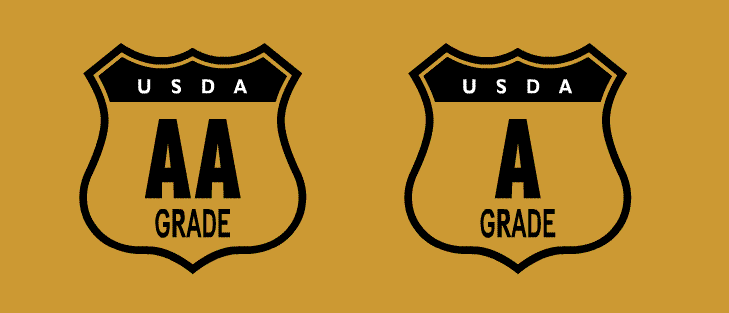USDA Grading & Inspection
USDA Grading
U.S. Department of Agriculture (USDA) standards are used throughout the U.S. industry to classify shell eggs into three consumer grades: USDA Grade AA, USDA Grade A and USDA Grade B. Grade does not describe food value; it is a measure of quality.
The grading process examines both the exterior and interior of the egg. Shells are inspected for cleanliness, strength, shape and texture. USDA Grade AA and USDA Grade A eggs have shells that are clean, smooth and sound.
Interior inspection is by candling or breaking out a sample. During candling, eggs travel along a conveyor belt and pass over a light source where the defects become visible. Defective eggs are removed. Hand candling or holding a shell egg directly in front of a light source is done to spot check and determine accuracy in grading. USDA Grade AA and USDA Grade A eggs have a very shallow air cell: clear, firm albumen and distinct firm yolks. Discoloration, blemishes, spots or floating bodies inside the egg result in down grading.
Breakout grading in based on a measurement known as the Haugh Unit System. Eggs are broken onto a flat surface for the albumen to be measured by micrometer. Eggs with thick albumen generally grade highest.
Grade AA
A Grade AA egg will stand up tall. The yolk is firm and the area covered by the white is small. There is a large proportion of thick white to thin white.
Grade A
A Grade A egg covers a relatively small area. The yolk is round and upstanding. The thick white is large in proportion to the thin white and stands fairly well around the yolk.
Grade B
A Grade B egg spreads out more. The yolk is flattened and there is about as much (or more) thin white as thick white.
Size classification of shell eggs show egg weight in ounces per dozen. Size has no effect on quality; eggs of any size may be included in each quality grade. However, the average of the sizes much equal or exceed the size classification. Most other egg-producing countries do not have such stringent regulations on sizing and egg sizes will not be as uniform as those or U.S. eggs.
The USDA Grade mark, in the form of a shield printed on the carton, certifies that the eggs have been graded for quality and sorted for size.

USDA Inspection
The Egg Products Inspection Act, administered by the U.S. Department of Agriculture, places specific inspection requirements on both shell eggs and egg products. Companies that pack, ship, process or market eggs or egg products operate under close government supervision. In order for shell eggs to be eligible for on official USDA grade stamp, they must be graded by a plant grader and then certified by a USDA grader.


